Early Warning Signs in Tree Crowns as a Response to the Impact of Drought
Abstract
1. Introduction
2. Thematic Framework
3. Materials and Methods
3.1. Observation Area
3.2. Primary Data Source
3.3. Literature Search Strategies and Selection Criteria
3.4. Long-Term Drought Analysis
4. Results and Discussion
4.1. Droughts Analysis
4.2. Stress Response Under Extreme Events
4.2.1. Small Leaf
4.2.2. Premature Discolouration (Ageing) of Needles and Leaves
4.2.3. Premature Abscission of Needles and Leaves
4.2.4. Defoliation
| References | Country/ Region | Species | Main Findings/Period |
|---|---|---|---|
| [11] | Italy (Tuscany) | Many species | Drought affected premature discolouration of leaves, premature abscission of leaves, and defoliation (2017–2018). |
| [20] | Serbia (Tara NP) | Several species | During drought periods, tree species diversity will not significantly reduce defoliation and mortality, especially for species considered drought-intolerant (2004–2021). |
| [47] | Serbia (country) | Many species | Drought increases defoliation and the progression of mortality, which may continue even after the drought ends (2004–2018). |
| [81] | Germany (country) | Several species | Significant correlations were found between defoliation and deviations from long-term average temperatures in all examined tree species (1990–2004). |
| [92] | Europe | Several species | Severe climate change and drought are the main drivers of increased defoliation in certain species (2001, 2006, and 2011). |
| [93] | Europe | Several species | The spatial distribution of defoliation trends shows a clear pattern of significant deterioration due to meteorological differences (1986–1995). |
| [94] | Italy (country) | Several species | The recurrence of extreme heatwaves and droughts can increase forest vulnerability, with increased tree mortality expected in the future (1997–2020). |
| [95] | Europe | Many species | The complex events of hot summers and drought years have caused tree mortality across Europe, with a continuous increase detected in southern and eastern Europe (1993–2013). |
| [96] | Europe | Many species | Mortality patterns in European forests show a concerning upward trend that could be further accelerated by droughts (1995–2020). |
| [97] | Slovakia (country) | Many species | Drought significantly impacted defoliation in the studied year (2022). |
| [100] | Croatia (country) | Fagus sylvatica | Drought from the previous year affects beech defoliation in the following year (1996–2017). |
5. Conclusions
Supplementary Materials
Author Contributions
Funding
Data Availability Statement
Conflicts of Interest
References
- Valcu, C.M. Proteome Changes Following Biotic and Abiotic Stress in Forest Trees. Ph.D. Disertation, Technischen Universität München, Fachgebiet Forstgenetik, München, Germany, 2007. [Google Scholar]
- Feeley, K.J.; Bernal-Escobar, M.; Fortier, R.; Kullberg, A.T. Tropical Trees Will Need to Acclimate to Rising Temperatures—But Can They? Plants 2023, 12, 3142. [Google Scholar] [CrossRef] [PubMed]
- Nicotra, A.B.; Atkin, O.K.; Bonser, S.P.; Davidson, A.M.; Finnegan, E.J.; Mathesius, U.; Poot, P.; Purugganen, M.D.; Richards, C.L.; Valladares, F.; et al. Plant phenotypic plasticity in a changing climate. Trends Plant Sci. 2010, 15, 684–692. [Google Scholar] [CrossRef] [PubMed]
- McDowell, N.; Pockman, W.T.; Allen, C.D.; Breshears, D.D.; Cobb, N.; Kolb, T.; Plaut, J.; Sperry, J.; West, A.; Williams, D.G.; et al. Mechanisms of plant survival and mortality during drought: Why do some plants survive while others succumb to drought. New Phytol. 2008, 178, 719–739. [Google Scholar] [CrossRef]
- Jardine, K.J.; Dewhirst, R.A.; Som, S.; Lei, J.; Tucker, E.; Young, R.P.; Portillo-Estrada, M.; Gao, Y.; Su, L.; Fares, S. Cell wall ester modifications and volatile emission signatures of plant response to abiotic stress. Plant Cell Environ. 2022, 45, 3429–3444. [Google Scholar] [CrossRef] [PubMed]
- Bigler, C.; Vitasse, Y. Premature leaf discoloration of European deciduous trees is caused by drought and heat in late spring and cold spells in early fall. Agric. For. Meteorol. 2021, 307, 108492. [Google Scholar] [CrossRef]
- Mediavilla, S.; Martínez-Ortega, M.; Andrés, S.; Bobo, J.; Escudero, A. Premature losses of leaf area in response to drought and insect herbivory through a leaf lifespan gradient. J. For. Res. 2021, 33, 39–50. [Google Scholar] [CrossRef]
- Weithmann, G.; Schuldt, B.; Link, R.M.; Heil, D.; Hoeber, S.; John, H.; Müller-Haubold, H.; Schüller, L.-M.; Schumann, K.; Leuschner, C. Leaf trait modification in European beech trees in response to climatic and edaphic drought. Plant Biol. 2021, 24, 1272–1286. [Google Scholar] [CrossRef]
- Eichhorn, J.; Roskams, P. Chapter 8—Assessment of Tree Condition. Dev. Environ. Sci. 2013, 12, 139–167. [Google Scholar] [CrossRef]
- Bréda, N.; Huc, R.; Granier, A.; Dreyer, E. Temperate forest trees and stands under severe drought: A review of ecophysiological responses, adaptation processes and long-term consequences. Ann. For. Sci. 2006, 63, 625–644. [Google Scholar] [CrossRef]
- Pollastrini, M.; Puletti, N.; Selvi, F.; Iacopetti, G.; Bussotti, F. Widespread Crown Defoliation After a Drought and Heat Wave in the Forests of Tuscany (Central Italy) and Their Recovery—A Case Study from Summer 2017. Front. For. Glob. Change 2019, 2, 74. [Google Scholar] [CrossRef]
- Rigling, A.; Etzold, S.; Bebi, P.; Brang, P.; Ferretti, M.; Forrester, D.; Gärtner, H.; Gessler, A.; Ginzler, C.; Moser, B.; et al. Wie viel Trockenheit ertragen unsere Wälder? Lehren aus extremen Trockenjahren. Forum Wissen 2019, 78, 39–51. [Google Scholar] [CrossRef]
- Schuldt, B.; Buras, A.; Arend, M.; Vitasse, Y.; Beierkuhnlein, C.; Damm, A.; Gharun, M.; Grams, T.E.E.; Hauck, M.; Hajek, P.; et al. A first assessment of the impact of the extreme 2018 summer drought on Central European forests. Basic Appl. Ecol. 2020, 45, 86–103. [Google Scholar] [CrossRef]
- Yang, X.; Lu, M.; Wang, Y.; Wang, Y.; Liu, Z.; Chen, S. Response Mechanism of Plants to Drought Stress. Horticulturae 2021, 7, 50. [Google Scholar] [CrossRef]
- Bennett, A.; McDowell, N.; Allen, C.; Anderson-Teixeira, K.J. Larger trees suffer most during drought in forests worldwide. Nat. Plants 2015, 1, 15139. [Google Scholar] [CrossRef] [PubMed]
- Mathes, T.; Seidel, D.; Klemmt, H.J.; Thom, D.; Annighöfer, P. The effect of forest structure on drought stress in beech forests (Fagus sylvatica L.). For. Ecol. Manag. 2024, 554, 121667. [Google Scholar] [CrossRef]
- Pretzsch, H.; Schütze, G.; Biber, P. Drought can favour the growth of small in relation to tall trees in mature stands of Norway spruce and European beech. For. Ecosyst. 2018, 5, 20. [Google Scholar] [CrossRef]
- Gillerot, L.; Forrester, D.I.; Bottero, A.; Rigling, A.; Lévesque, M. Tree Neighbourhood Diversity Has Negligible Effects on Drought Resilience of European Beech, Silver Fir and Norway Spruce. Ecosystems 2021, 24, 20–36. [Google Scholar] [CrossRef]
- de Sauvage, J.C.; Bugmann, H.; Bigler, C.; Lévesque, M. Species diversity and competition have minor effects on the growth response of silver fir, European larch and Douglas fir to drought. Agr. For. Meteorol. 2023, 341, 109664. [Google Scholar] [CrossRef]
- Češljar, G.; Čule, N.; Đorđević, I.; Eremija, S.; Momirović, N.; Tomić, M.; Jovanović, F. Can the desiccation of forests in Tara National Park (Serbia) be attributed to the effects of a drought period? J. For. Res. 2024, 35, 96. [Google Scholar] [CrossRef]
- Anderegg, L.D.L.; Anderegg, W.R.L.; Berry, J.A. Not all droughts are created equal: Translating meteorological drought into woody plant mortality. Tree Physiol. 2023, 33, 672–683. [Google Scholar] [CrossRef]
- Buras, A.; Rammig, A.; Zang, C.S. The European Forest Condition Monitor: Using Remotely Sensed Forest Greenness to Identify Hot Spots of Forest Decline. Front. Plant Sci. 2021, 12, 689220. [Google Scholar] [CrossRef] [PubMed]
- Jiang, Y.; Marchand, W.; Rydval, M.; Matula, R.; Janda, P.; Begović, K.; Thom, D.; Fruleux, A.; Buechling, A.; Pavlin, J.; et al. Drought resistance of major tree species in the Czech Republic. Agric. For. Meteorol. 2024, 348, 109933. [Google Scholar] [CrossRef]
- Bose, A.K.; Scherrer, D.; Camarero, J.J.; Ziche, D.; Babst, F.; Bigler, C.; Bolte, A.; Dorado-Liñán, I.; Etzold, S.; Fonti, P.; et al. Climate sensitivity and drought seasonality determine post-drought growth recovery of Quercus petraea and Quercus robur in Europe. Sci. Total Environ. 2021, 784, 147222. [Google Scholar] [CrossRef] [PubMed]
- Leuschner, C. Drought response of European beech (Fagus sylvatica L.)—A review. Perspect. Plant Ecol. Evol. Syst. 2020, 47, 125576. [Google Scholar] [CrossRef]
- FISE. Forest Information System for Europe 2024. Available online: https://forest.eea.europa.eu/topics/forest-management/tree-species-selection (accessed on 28 November 2024).
- NFI. National Forest Inventory of the Republic of Serbia 2023. Available online: https://upravazasume.gov.rs/oglasna-tabla/naredbu-o-proglasenju-prirodne-nepogode-i-merama-zastite-i-sanacije-suma-ostecenih-vetrolomima-i-vetroizvalama-2/ (accessed on 28 November 2024).
- Camarero, J.J.; Gazol, A.; Sangüesa-Barreda, G.; Vergarechea, M.; Alfaro-Sánchez, R.; Cattaneo, N.; Vicente-Serrano, S.M. Tree growth is more limited by drought in rear-edge forests most of the times. For. Ecosyst. 2021, 8, 25. [Google Scholar] [CrossRef]
- Wankmüller, F.J.P.; Delval, L.; Lehmann, P.; Baur, M.J.; Cecere, A.; Wolf, S.; Or, D.; Javaux, M.; Carminati, A. Global influence of soil texture on ecosystem water limitation. Nature 2024, 635, 631–638. [Google Scholar] [CrossRef]
- Zhang, Q.; Shao, M.; Jia, X.; Wei, X. Changes in soil physical and chemical properties after short drought stress in semi-humid forests. Geoderma 2019, 338, 170–177. [Google Scholar] [CrossRef]
- Lindh, M.; Zhang, L.; Falster, D.; Franklin, O.; Brännström, A. Plant diversity and drought: The role of deep roots. Ecol. Model. 2014, 290, 85–93. [Google Scholar] [CrossRef]
- RHSS. Republic Hydrometeorological Service of Serbia. Seasonal Climate Characteristics for the Territory of Serbia. Republic Hydrometeorological Service of Serbia, Belgrade. Available online: https://www.hidmet.gov.rs/eng/meteorologija/klimatologija_produkti.php (accessed on 20 October 2024).
- CCS. Climate Change Service. Record ‘Warm Daytimes’ in Southeastern Europe: C3S Seasonal Lookback: Summer 2024. Available online: https://climate.copernicus.eu/c3s-seasonal-lookback-summer-2024 (accessed on 25 October 2024).
- ICP Forests. International Co-Operative Programme on Assessment and Monitoring of Air Pollution Effects on Forests. Available online: http://icp-forests.net/ (accessed on 25 October 2024).
- Camarero, J.J.; Gazol, A.; Sangüesa-Barreda, G.; Oliva, J.; Vicente-Serrano, S. To die or not to die: Early-warning signals of dieback in response to a severe drought. J. Ecol. 2015, 103, 44–57. [Google Scholar] [CrossRef]
- Liu, Y.; Kumar, M.; Katul, G.G.; Porporato, A. Reduced resilience as an early warning signal of forest mortality. Nat. Clim. Change 2019, 9, 880–885. [Google Scholar] [CrossRef]
- Sangüesa-Barreda, G.; Gazol, A.; Camarero, J.J. Drops in needle production are early-warning signals of drought-triggered dieback in Scots pine. Trees 2023, 37, 1137–1151. [Google Scholar] [CrossRef]
- Georgieva, M.; Vassileva, V. Stress Management in Plants: Examining Provisional and Unique Dose-Dependent Responses. Int. J. Mol. Sci. 2023, 24, 5105. [Google Scholar] [CrossRef] [PubMed]
- Nikolaus, A.; Klaus, A.; Sacha, B.; Nina, B.; Markus, G.; Felix, K.; Christian, K.; Enrico, M.; Lutz, M.; Christine, M.; et al. Plant Response to Stress. Zurich-Basel Plant Sciences Center; PSC: Basel, Switzerland, 2012; pp. 8–153. [Google Scholar]
- Levitt, J. Responses of Plants to Environmental Stresses; Academic Press: Cambridge, MA, USA, 1980; Volume 1, p. 496. [Google Scholar]
- Lichtenthaler, H.K. Vegetation Stress: An Introduction to the Stress Concept in Plants. J. Plant Physiol. 1996, 148, 4–14. [Google Scholar] [CrossRef]
- Dai, A. Drought under global warming: A review Wiley Interdiscipl. Rev. Clim. Change 2011, 2, 45–65. [Google Scholar] [CrossRef]
- Moravec, V.; Markonis, Y.; Rakovec, O.; Svoboda, M.; Trnka, M.; Kumar, R.; Hanel, M. Europe under multi-year droughts: How severe was the 2014–2018 drought period? Environ. Res. Lett. 2021, 16, 034062. [Google Scholar] [CrossRef]
- Trugman, A.T.; Anderegg, L.D.L.; Anderegg, W.R.L.; Das, A.J.; Stephenson, N.L. Why is Tree Drought Mortality so Hard to Predict? Trends Ecol. Evol. 2021, 36, 520–532. [Google Scholar] [CrossRef]
- Ryan, M.G. Tree responses to drought. Tree Physiol. 2011, 31, 237–239. [Google Scholar] [CrossRef]
- Bonal, D.; Burban, B.; Stahl, C.; Wagner, F.; Hérault, B. The response of tropical rainforests to drought—Lessons from recent research and future prospects. Ann. For. Sci. 2016, 73, 27–44. [Google Scholar] [CrossRef]
- Češljar, G.; Jovanović, F.; Brašanac-Bosanac, L.; Đorđević, I.; Mitrović, S.; Eremija, S.; Ćirković-Mitrović, T.; Lučić, A. Impact of an Extremely Dry Period on Tree Defoliation and Tree Mortality in Serbia. Plants 2022, 11, 1286. [Google Scholar] [CrossRef]
- Češljar, G.; Đorđević, I.; Brašanac-Bosanac, L.; Eremija, S.; Mitrović, S.; Ćirković-Mitrović, T.; Lučić, A. Determination of forest decline due to the action of dominant stress factor through monitoring of defoliation—Case study of Maljen, Serbia. Agric. For. 2021, 67, 211–226. [Google Scholar] [CrossRef]
- RHSS. Republic Hydrometeorological Service of Serbia. Basic Climate Characteristics for the Territory of Serbia. Republic Hydrometeorological Service of Serbia, Belgrade. Available online: https://www.hidmet.gov.rs/eng/meteorologija/klimatologija_srbije.php (accessed on 5 December 2024).
- Kottek, M.; Grieser, J.; Beck, C.; Rudolf, B.; Rubel, F. World Map of the Koppen-Geiger climate classification updated. Meteorol. Z. 2006, 15, 259–263. [Google Scholar] [CrossRef]
- Mihajlović, J. Application of Recent Climate Classifications for the Climate Regionalization of Serbia. Ph.D. Dissertation, Faculty of Geography, University of Belgrade, Belgrade, Serbia, 2018; pp. 1–368. Available online: https://nardus.mpn.gov.rs/handle/123456789/10657 (accessed on 30 January 2025). (In Serbian).
- Eichhorn, J.; Roskams, P.; Potočić, N.; Timmermann, V.; Ferretti, M.; Mues, V.; Szepesi, A.; Durrant, D.; Seletković, I.; Schröck, H.-W.; et al. ICP Forests Manual Part IV. Visual Assessment of Crown Condition and Damaging Agents. Version 2020-3. 2020; pp. 5–54. Available online: https://storage.ning.com/topology/rest/1.0/file/get/9995547265?profile=original (accessed on 20 October 2024).
- Greenhalgh, T.; Peacock, R. Effectiveness and efficiency of search methods in systematic reviews of complex evidence: Audit of primary sources. BMJ 2005, 331, 1064. [Google Scholar] [CrossRef] [PubMed]
- Vicente-Serrano, S.M.; Beguería, S.; López-Moreno, J.I. A Multi-scalar drought index sensitive to global warming: The Standardized Precipitation Evapotranspiration Index—SPEI. J. Clim. 2010, 23, 1696–1718. [Google Scholar] [CrossRef]
- SPEI. Standardized Precipitation Evapotranspiration Index Database. Available online: http://sac.csic.es/spei/database.html (accessed on 25 November 2024).
- Thornthwaite, C.W. An approach toward a rational classification of climate. Geogr. Rev. 1948, 38, 55–94. [Google Scholar] [CrossRef]
- EEA. European Environment Agency. Drought Impact on Ecosystems in Europe. Available online: https://www.eea.europa.eu/en/analysis/indicators/drought-impact-on-ecosystems-in-europe (accessed on 5 December 2024).
- Stovall, A.E.L.; Shugart, H.; Yang, X. Tree height explains mortality risk during an intense drought. Nat. Commun. 2019, 10, 4385. [Google Scholar] [CrossRef]
- Zhu, J.; Thimonier, A.; Etzold, S.; Meusburger, K.; Waldner, P.; Schmitt, M.; Schleppi, P.; Schaub, M.; Thormann, J.J.; Lehmann, M.M. Variation in Leaf Morphological Traits of European Beech and Norway Spruce Over Two Decades in Switzerland. Frontiers 2022, 4, 2021. [Google Scholar] [CrossRef]
- Poorter, H.; Niinemets, Ü.; Poorter, L.; Wright, I.J.; Villar, R. Causes and consequences of variation in leaf mass per area (LMA): A meta-analysis. New Phytol. 2009, 182, 565–588. [Google Scholar] [CrossRef]
- Sanginés de Cárcer, P.; Signarbieux, C.; Schlaepfer, R.; Buttler, A.; Vollenweider, P. Responses of antinomic foliar traits to experimental climate forcing in beech and spruce saplings. Environ. Exp. Bot. 2017, 140, 128–140. [Google Scholar] [CrossRef]
- Caudullo, G.; De Rigo, D.; Mauri, A.; Houston, D.T.; San-Miguel-Ayanz, J. European Atlas of Forest Tree Species; Caudullo, G., De Rigo, D., Mauri, A., Houston Durrant, T., San-Miguel-Ayanz, J., Eds.; European Commission, Joint Research Centre, Publications Office of the European Union: Brussels, Belgium, 2016; Available online: https://data.europa.eu/doi/10.2760/776635 (accessed on 28 November 2024).
- Šijačić-Nikolić, M.; Milovanović, J.; Nonić, M.; Knežević, R.; Stanković, D. Leaf morphometric characteristics variability of different beech provenances in juvenile development stage. Genetika 2013, 45, 369–380. [Google Scholar] [CrossRef]
- Bresson, C.C.; Vitasse, Y.; Kremer, A.; Delzon, S. To what extent is altitudinal variation of functional traits driven by genetic adaptation in European oak and beech? Tree Physiol. 2011, 31, 1164–1174. [Google Scholar] [CrossRef]
- Roloff, A. Morphology of Crown Development of Fagus sylvatica L. (Beech) in Consideration of New Modifications: I. Morphogenetic Cycle, Abnormalities Specific to Proleptic Shoots and Leaf Fall. Flora 1987, 179, 355–378. [Google Scholar] [CrossRef]
- Arend, M.; Link, R.M.; Zahnd, C.; Hoch, G.; Schuldt, B.; Kahmen, A. Lack of hydraulic recovery as a cause of post-drought foliage reduction and canopy decline in European beech. New Phytol. 2022, 234, 1195–1205. [Google Scholar] [CrossRef] [PubMed]
- Maréchaux, I.; Saint-André, L.; Bartlett, M.K.; Sack, L.; Chave, J. Leaf drought tolerance cannot be inferred from classic leaf traits in a tropical rainforest. J. Ecol. 2020, 108, 1030–1045. [Google Scholar] [CrossRef]
- Boutsios, S.; Vidalis, A.; Adamidis, G.C.; Hatziskakis, S.; Varsamis, G.; Tsiripidis, I.; Karanikola, P.; Papageorgiou, A.C. Diversity in Shade and Light Leaf Morphology in Beech Populations of South Rodopi Mountains. Proc. Natl. Acad. Sci. India Sect. B Biol. Sci. 2020, 91, 53–61. [Google Scholar] [CrossRef]
- Adamidis, G.C.; Georgios, V.; Ioannis, T.; Panayiotis, G.D.; Aristotelis, C.P. Patterns of Leaf Morphological Traits of Beech (Fagus sylvatica L.) along an Altitudinal Gradient. Forests 2021, 12, 1297. [Google Scholar] [CrossRef]
- Polle, A.; Schwanz, P.; Rudolf, C. Developmental and seasonal changes of stress responsiveness in beech leaves (Fagus sylvatica L.). Plant Cell Environ. 2001, 24, 821–829. [Google Scholar] [CrossRef]
- Rukh, S.; Sanders, T.G.M.; Krüger, I.; Schad, T.; Bolte, A. Distinct Responses of European Beech (Fagus sylvatica L.) to Drought Intensity and Length—A Review of the Impacts of the 2003 and 2018–2019 Drought Events in Central Europe. Forests 2023, 14, 248. [Google Scholar] [CrossRef]
- De la Riva, E.G.; Olmo, M.; Poorter, H.; Ubera, J.L.; Villar, R. Leaf Mass per Area (LMA) and Its Relationship with Leaf Structure and Anatomy in 34 Mediterranean Woody Species along a Water Availability Gradient. PLoS ONE 2016, 11, e0148788. [Google Scholar] [CrossRef]
- Thomas, F.M.; Preusser, S.; Backes, B.; Werner, W. Leaf traits of Central-European beech (Fagus sylvatica) and oaks (Quercus petraea/robur): Effects of severe drought and long-term dynamics. For. Ecol. Manag. 2024, 559, 121823. [Google Scholar] [CrossRef]
- Wu, C.; Peng, J.; Ciais, P.; Peñuelas, J.; Wang, H.; Beguería, S.; Black, T.A.; Jassal, R.S.; Zhang, X.; Yuan, W.; et al. Increased drought effects on the phenology of autumn leaf senescence. Nat. Clim. Change 2022, 12, 943–949. [Google Scholar] [CrossRef]
- Ma, C.; Wang, X.; Wu, C. Early leaf senescence under drought conditions in the Northern hemisphere. Agric. For. Meteorol. 2024, 358, 110231. [Google Scholar] [CrossRef]
- Polgar, C.A.; Primack, R.B. Leaf-out phenology of temperate woody plants: From trees to ecosystems. New Phytol. 2011, 191, 926–941. [Google Scholar] [CrossRef]
- Sharma, A.; Kumar, V.; Shahzad, B.; Ramakrishnan, M.; Singh Sidhu, G.P.; Bali, A.S.; Handa, N.; Kapoor, D.; Yadav, P.; Khanna, K.; et al. Photosynthetic Response of Plants Under Different Abiotic Stresses: A Review. J. Plant Growth Regul. 2020, 39, 509–531. [Google Scholar] [CrossRef]
- Penuelas, J.; Rutishauser, T.; Filella, I. Phenology feedbacks on climate change. Science 2009, 324, 887–888. [Google Scholar] [CrossRef] [PubMed]
- Keskitalo, J.G.; Bergquist, P.; Gardeström, S.; Jansson, S. A cellular timetable of autumn senescence. Plant Physiol. 2005, 139, 1635–1648. [Google Scholar] [CrossRef]
- Frei, E.R.; Gossner, M.M.; Vitasse, Y.; Queloz, V.; Dubach, V.; Gessler, A.; Ginzler, C.; Hagedorn, F.; Meusburger, K.; Moor, M.; et al. European beech dieback after premature leaf senescence during the 2018 drought in northern Switzerland. Plant Biol. 2022, 24, 1132–1145. [Google Scholar] [CrossRef]
- Seidling, W. Signals of summer drought in crown condition data from the German Level I network. Eur. J. Forest. Res. 2007, 126, 529–544. [Google Scholar] [CrossRef]
- McCulloh, K.A.; Augustine, S.P.; Goke, A.; Jordan, R.; Krieg, C.P.; O’Keefe, K.; Smith, D.D. At least it is a dry cold: The global distribution of freeze–thaw and drought stress and the traits that may impart poly-tolerance in conifers. Tree Physiol. 2023, 43, 1–15. [Google Scholar] [CrossRef]
- Song, Y.; Sass-Klaassen, U.; Sterck, F.; Goudzwaard, L.; Akhmetzyanov, L.; Poorter, L. Growth of 19 conifer species is highly sensitive to winter warming, spring frost and summer drought. Ann. Bot. 2021, 128, 545–557. [Google Scholar] [CrossRef]
- Charrier, G.; Martin-StPaul, N.; Damesin, C.; Deloierre, N.; Hänninen, H.; Torres-Ruiz, J.M.; Davi, H. Interaction of drought and frost in tree ecophysiology: Rethinking the timing of risks. Ann. For. Sci. 2021, 78, 40. [Google Scholar] [CrossRef]
- Pekeč, S.; Drekić, M.; Milović, M.; Karaklić, V. Phenological phases of leaf unfolding and leaf fall of sessile oak (Quercus petraea Matt./Liebl.) at the second level bioindication point in Fruška gora. Šumarstvo 2020, 1–2, 119–126. (In Serbian) [Google Scholar]
- Descals, A.; Verger, A.; Yin, G.; Filella, I.; Peñuelas, J. Widespread drought-induced leaf shedding and legacy effects on productivity in European deciduous forests. Remote Sens. Ecol. Conserv. 2022, 9, 76–89. [Google Scholar] [CrossRef]
- Massonnet, C.; Chuste, P.-A.; Levillain, J.; Gérémia, F.; Silva, D.E.; Maillard, P.; Dreyer, E.; Dupouey, J.-L.; Bréda, N. Leafy season length is reduced by a prolonged soil water deficit but not by repeated defoliation in beech trees (Fagus sylvatica L.): Comparison of response among regional populations grown in a common garden. Agric. For. Meteorol. 2021, 297, 108228. [Google Scholar] [CrossRef]
- Arend, M.; Gessler, A.; Schaub, M. The influence of the soil on spring and autumn phenology in European beech. Tree Physiol. 2016, 36, 78–85. [Google Scholar] [CrossRef][Green Version]
- Wolfe, B.T.; Sperry, J.S.; Kursar, T.A. Does leaf shedding protect stems from cavitation during seasonal droughts? A test of the hydraulic fuse hypothesis. New Phytol. 2016, 212, 1007–1018. [Google Scholar] [CrossRef]
- Walthert, L.; Ganthaler, A.; Mayr, S.; Saurer, M.; Waldner, P.; Walser, M.; Zweifel, R.; von Arx, G. From the comfort zone to crown dieback: Sequence of physiological stress thresholds in mature European beech trees across progressive drought. Sci. Total Environ. 2021, 753, 141792. [Google Scholar] [CrossRef] [PubMed]
- Savage, J. Expert Alert: The Drought’s Impact on Autumn Colors. University of Minnesota Duluth. 2021. Available online: https://news.d.umn.edu/articles/expert-alert-drought-and-fall-colors (accessed on 5 August 2024).
- De Marco, A.; Proietti, C.; Cionni, I.; Fischer, R.; Screpanti, A.; Vitale, M. Future impacts of nitrogen deposition and climate change scenarios on forest crown defoliation. Environ. Pollut. 2014, 194, 171–180. [Google Scholar] [CrossRef] [PubMed]
- De Vries, W.; Klap, J.M.; Erisman, J.W. Effects of environmental stress on forest crown condition in Europe. Part I: Hypotheses and approach to the study. Water Air Soil Pollut. 2000, 119, 317–333. [Google Scholar] [CrossRef]
- Bussotti, F.; Papitto, G.; Di Martino, D.; Cocciufa, C.; Cindolo, C.; Cenni, E.; Bettini, D.; Iacopetti, G.; Pollastrini, M. Defoliation, Recovery and Increasing Mortality in Italian Forests: Levels, Patterns and Possible Consequences for Forest Multifunctionality. Forests 2021, 12, 1476. [Google Scholar] [CrossRef]
- Gazol, A.; Camarero, J.J. Compound climate events increase tree drought mortality across European forests. Sci. Total Environ. 2022, 816, 151604. [Google Scholar] [CrossRef]
- George, J.-P.; Bürkner, P.-C.; Sanders, T.G.M.; Neumann, M.; Cammalleri, C.; Vogt, J.V.; Lang, M. Long-term forest monitoring reveals constant mortality rise in European forests. Plant Biol. 2022, 24, 1108–1119. [Google Scholar] [CrossRef] [PubMed]
- Bucha, T.; Pavlenda, P.; Konôpka, B.; Tomaštík, J.; Chudá, J.; Surový, P. Satellite Assessment of Forest Health in Drought Conditions: A Novel Approach Combining Defoliation and Discolouration. Forests 2024, 15, 1567. [Google Scholar] [CrossRef]
- Gottardini, E.; Cristofolini, F.; Cristofori, A.; Pollastrini, M.; Camin, F.; Ferretti, M. A multi-proxy approach reveals common and species-specific features associated with tree defoliation in broadleaved species. For. Ecol. Manag. 2020, 467, 118151. [Google Scholar] [CrossRef]
- Balducci, L.; Fierravanti, A.; Rossi, S.; Delzon, S.; De Grandpré, L.; Kneeshaw, D.D.; Deslauriers, A. The paradox of defoliation: Declining tree water status with increasing soil water content. Agric. For. Meteorol. 2020, 290, 108025. [Google Scholar] [CrossRef]
- Ognjenović, M.; Seletković, I.; Potočić, N.; Marušić, M.; Tadić, M.P.; Jonard, M.; Rautio, P.; Timmermann, V.; Lovreškov, L.; Ugarković, D. Defoliation Change of European Beech (Fagus sylvatica L.) Depends on Previous Year Drought. Plants 2022, 11, 730. [Google Scholar] [CrossRef]
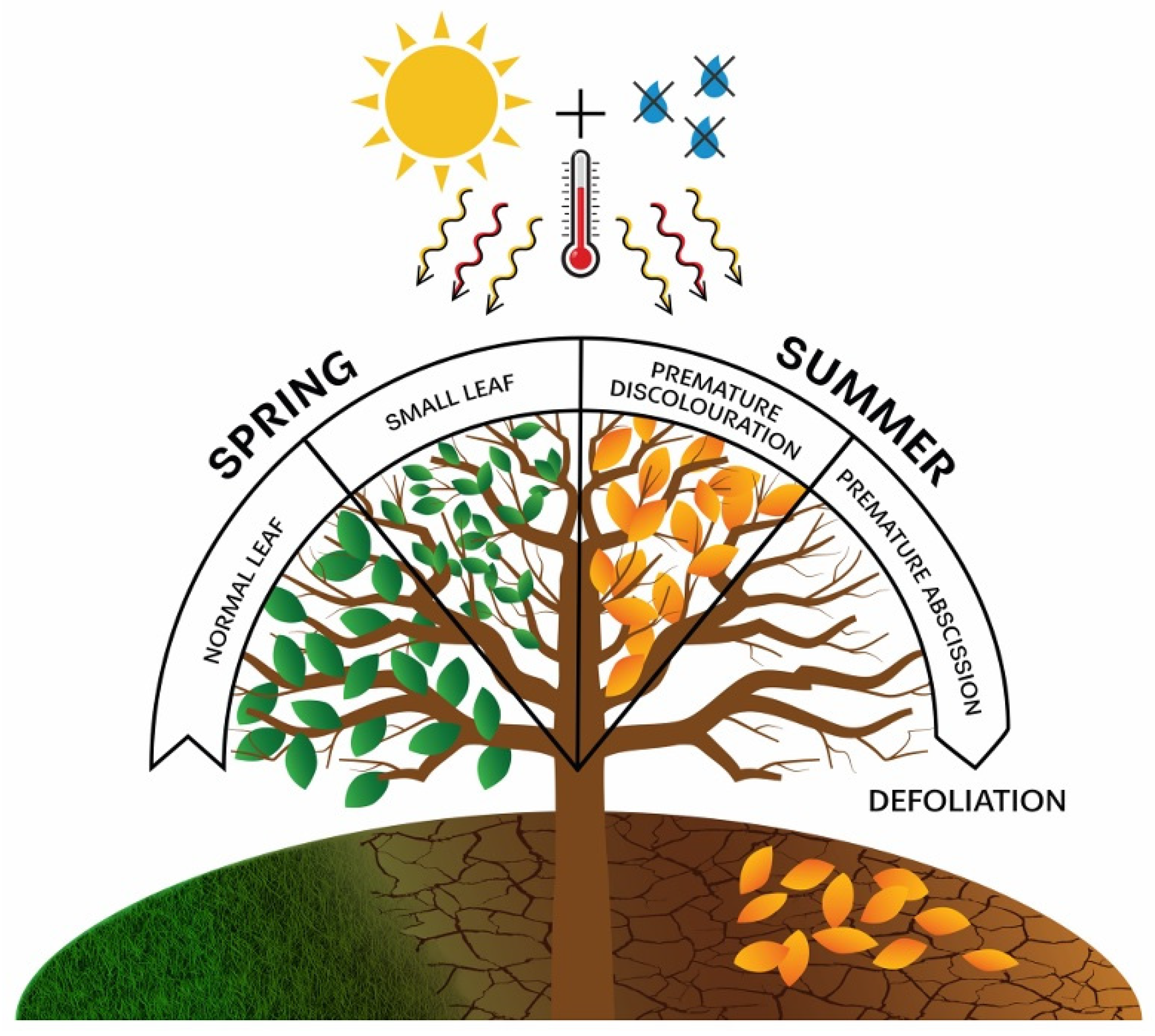
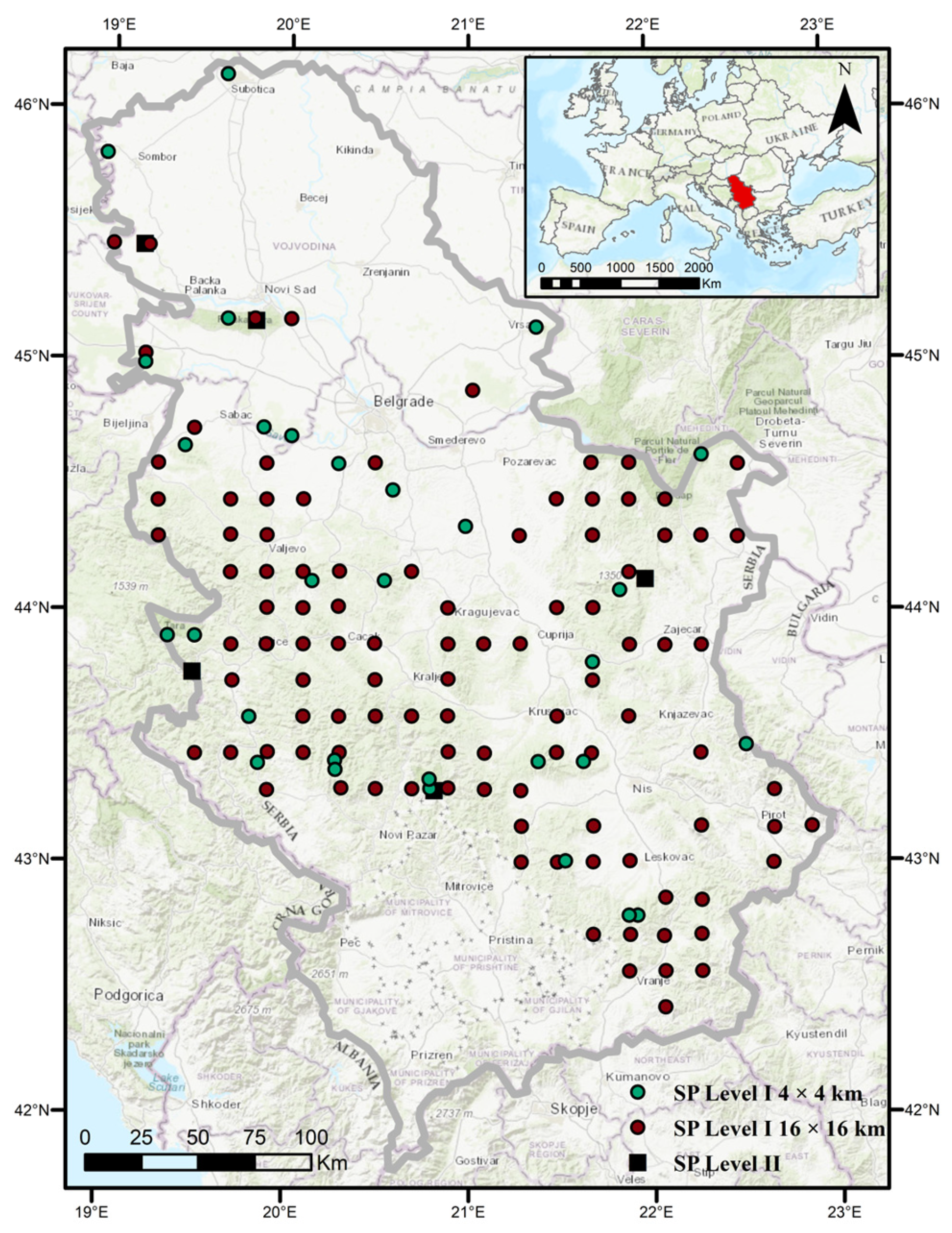


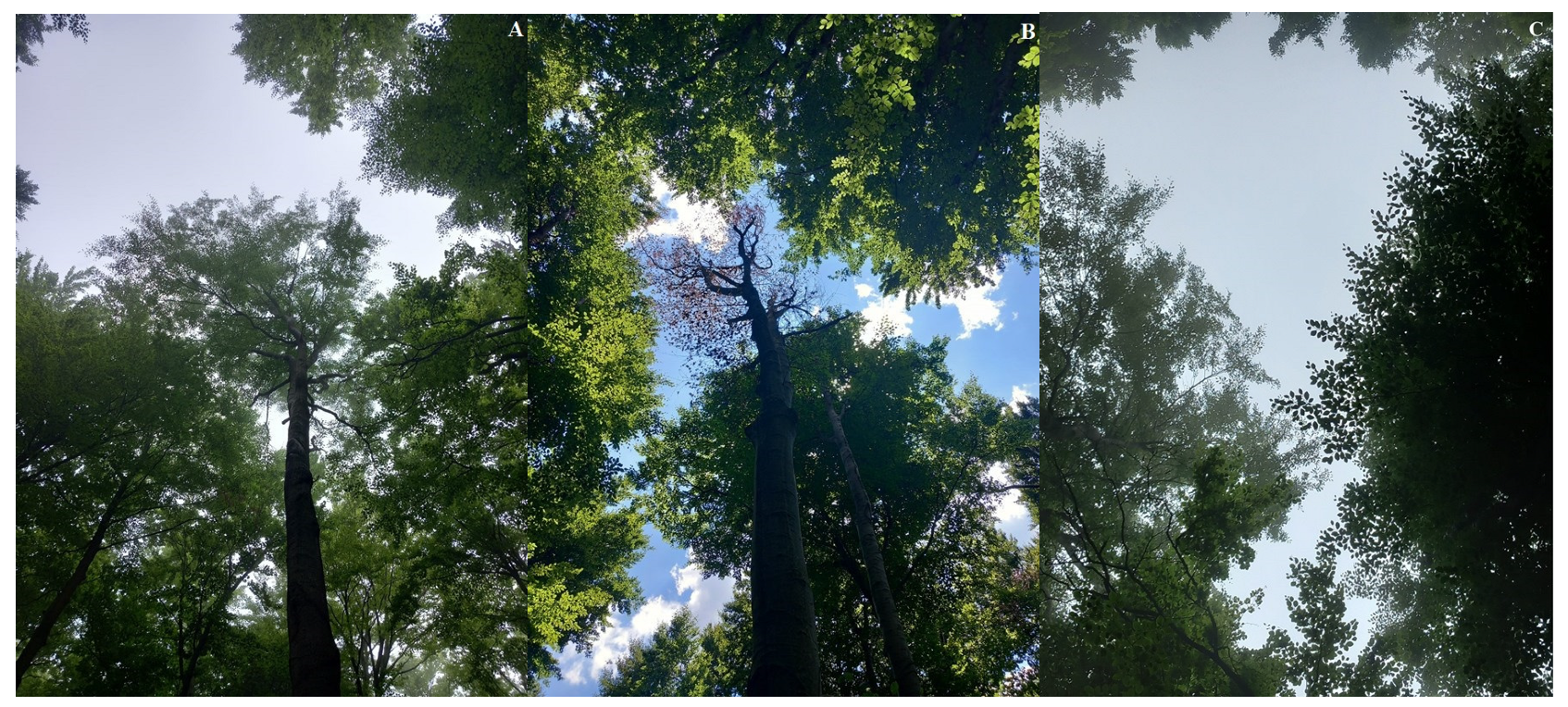
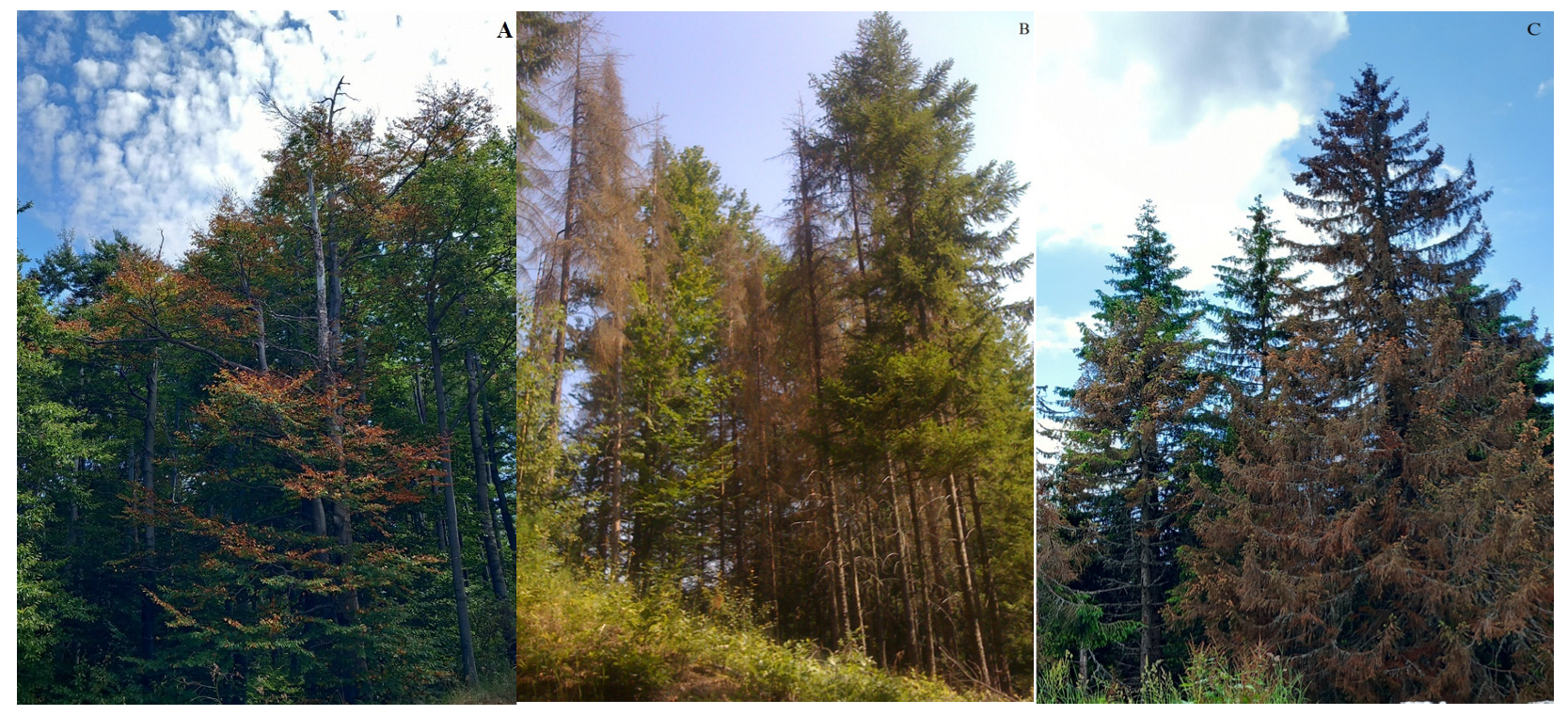
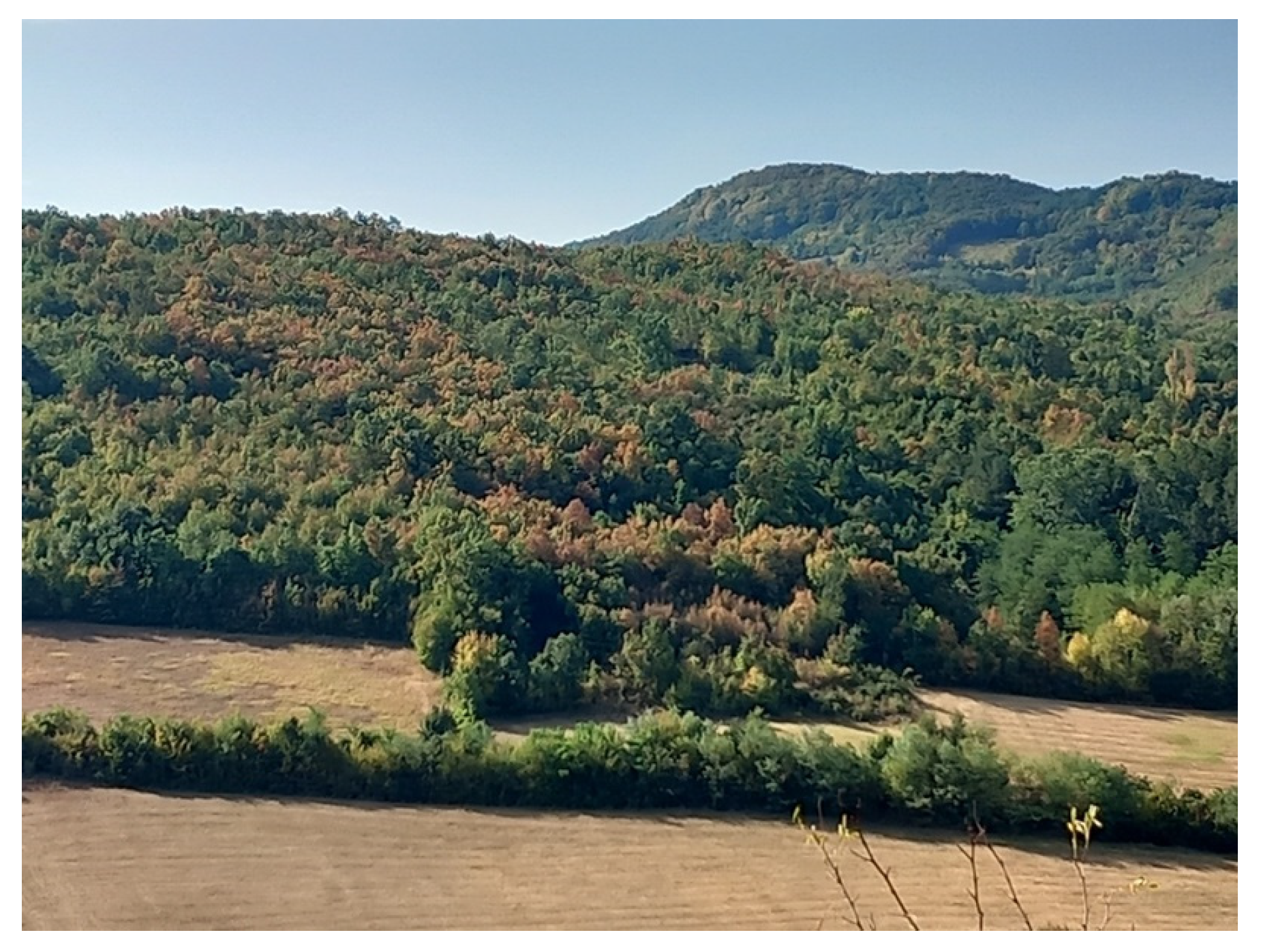


| References | Country/ Region | Species | Main Findings/Research Period |
|---|---|---|---|
| [8] | Germany (north) | Fagus sylvatica | The studied leaf traits varied significantly between years. Severe drought caused the formation of smaller leaves (2010, 2018, and 2019). |
| [59] | Switzerland (country) | Two species | Opposite effects on leaf morphological traits caused by the same driver in spatial and temporal analyses highlight the need for further investigation into the reasons behind specific leaf morphological traits and their responses to climate change (1995–2019). |
| [65] | Germany (country) | Fagus sylvatica | Early summer droughts reduce the number of leaves, while late summer droughts affect leaf size (1984–1985). |
| [66] | Switzerland (eastern) | Two species | Xylem does not restore its function in the season following a drought, and persistent hydraulic dysfunction in branches is compensated by a reduction in supported leaf area (2018–2019). |
| [68] | Europe (Rodopi mountains) | Two species | Shade leaves retain their size compared to leaves directly exposed to solar radiation (2020). |
| [70] | Germany (Göttingen) | Fagus sylvatica | The correlation of meteorological data suggests that high air temperatures and low precipitation may have predisposed beech leaves to lose stress resistance (1998–1999). |
| [73] | Germany (south-western) | Two species | Severe drought reduced beech’s leaf size and specific leaf area (2004–2021). |
| References | Country/ Region | Species | Main Findings/Research Period |
|---|---|---|---|
| [6] | Switzerland (country) | Several species | Climate stress, such as severe drought, can cause premature discolouration of leaves, and it is emphasised that its frequency is expected to increase in the future (1971–2018). |
| [10] | Europe | Many species | Severe and prolonged drought impacted soil water deficits and caused stress symptoms in many trees, such as premature discolouration of leaves and premature abscission (2003). |
| [11] | Italy (Tuscany) | Many species | Drought affected premature discolouration of leaves, premature abscission of leaves, defoliation, and tree mortality (2017–2018). |
| [12] | Switzerland (country) | Many species | During the dry and hot summer, many forested areas suffer from premature discolouration of leaves and premature abscission of leaves (2018). |
| [13] | Europe (central) | Many species | Due to extreme drought, widespread discolouration of leaves and premature abscission of leaves were observed, leading to unprecedented tree mortality (2018–2019). |
| [71] | Europe (central) | Fagus sylvatica | The effects of drought periods on European beech were similar in terms of stress responses, expressed through reduced growth, defoliation, and premature discolouration of leaves (2003, 2018, and 2019). |
| [74] | Northern Hemisphere | Many species | Earlier foliar ageing has been linked to reduced precipitation due to warming and lower drought resistance (1982–2015). |
| [76] | Globally | Many species | Global temperature increases have resulted in premature leafing, and in drought years, leaves tend to discolour and abscise more quickly (not specified). |
| [75] | Northern Hemisphere | Many species | Remote sensing data have confirmed significant changes in early autumn leaf ageing over recent decades due to previously documented drought periods (1982–1998 and 1999–2015). |
| [80] | Switzerland (north) | Fagus sylvatica | Beech trees with premature discolouration of leaves caused by drought had a higher mortality rate in subsequent years (2018–2021). |
| References | Country/ Region | Species | Main Findings/Research Period |
|---|---|---|---|
| [10] | Europe | Many species | Severe and prolonged drought affected soil water deficits and caused stress symptoms in many trees, such as premature discolouration and abscission of leaves (2003). |
| [11] | Italy (Tuscany) | Many species | Drought impacted premature discolouration and abscission of leaves, defoliation, and tree mortality (2017–2018). |
| [12] | Switzerland (country) | Many species | During the dry and hot summer, many forested areas suffer from premature discolouration and abscission of leaves (2018). |
| [13] | Europe (central) | Many species | Due to extreme drought, widespread leaf discolouration and premature abscission of leaves were observed, leading to unprecedented tree mortality (2018–2019). |
| [88] | Switzerland (country) | Fagus sylvatica | Spring bud break and autumn leaf senescence were more advanced in acidic soils, with a more significant impact on leaf senescence (2013–2014). |
| [86] | Europe | Many species | Canopy events indicate that premature abscission of leaves associated with heatwaves and droughts is more widespread and frequent than previously thought (2017–2021). |
| [87] | France (north-eastern) | Fagus sylvatica | The response of trees to premature abscission of leaves during years of intense drought will largely depend on soil water deficits (2014–2016). |
| [90] | Switzerland (country) | Fagus sylvatica | Premature abscission of leaves can be used as a predictor of crown dieback in the following year (2018–2020). |
| SP ** Level I | Locality | Altitude (m) | Stand Age | Tree Species | Defoliation (%) per Year | Group | ||||||||||
|---|---|---|---|---|---|---|---|---|---|---|---|---|---|---|---|---|
| 2004 | 2005 | 2006 | 2007 | 2008 | 2009 | 2010 | 2011 * | 2012 * | 2013 * | 2014 | ||||||
| 415 | Maljen | 630 | 61–80 | Fagus syilvatica | 20 | 20 | 20 | 10 | 10 | 10 | 5 | 0 | 0 | 80 | 100 | I |
| 28 | Potaj čuka | 619 | 61–80 | Fagus syilvatica | 10 | 0 | 0 | 20 | 15 | 10 | 5 | 10 | 5 | 0 | 100 | II |
| 96 | Muhovac | 850 | 41–60 | Fagus syilvatica | 0 | 0 | 0 | 0 | 70 | 90 | 40 | 30 | 30 | 100 | III | |
Disclaimer/Publisher’s Note: The statements, opinions and data contained in all publications are solely those of the individual author(s) and contributor(s) and not of MDPI and/or the editor(s). MDPI and/or the editor(s) disclaim responsibility for any injury to people or property resulting from any ideas, methods, instructions or products referred to in the content. |
© 2025 by the authors. Licensee MDPI, Basel, Switzerland. This article is an open access article distributed under the terms and conditions of the Creative Commons Attribution (CC BY) license (https://creativecommons.org/licenses/by/4.0/).
Share and Cite
Češljar, G.; Đorđević, I.; Eremija, S.; Marković, M.; Gagić Serdar, R.; Lučić, A.; Čule, N. Early Warning Signs in Tree Crowns as a Response to the Impact of Drought. Forests 2025, 16, 405. https://doi.org/10.3390/f16030405
Češljar G, Đorđević I, Eremija S, Marković M, Gagić Serdar R, Lučić A, Čule N. Early Warning Signs in Tree Crowns as a Response to the Impact of Drought. Forests. 2025; 16(3):405. https://doi.org/10.3390/f16030405
Chicago/Turabian StyleČešljar, Goran, Ilija Đorđević, Saša Eremija, Miroslava Marković, Renata Gagić Serdar, Aleksandar Lučić, and Nevena Čule. 2025. "Early Warning Signs in Tree Crowns as a Response to the Impact of Drought" Forests 16, no. 3: 405. https://doi.org/10.3390/f16030405
APA StyleČešljar, G., Đorđević, I., Eremija, S., Marković, M., Gagić Serdar, R., Lučić, A., & Čule, N. (2025). Early Warning Signs in Tree Crowns as a Response to the Impact of Drought. Forests, 16(3), 405. https://doi.org/10.3390/f16030405






